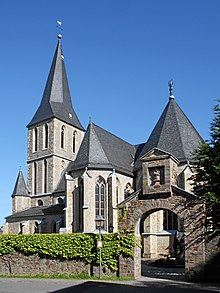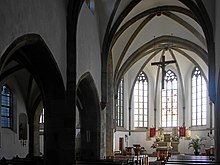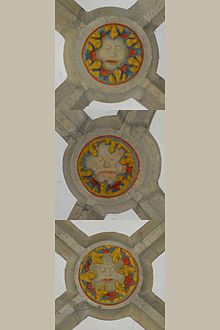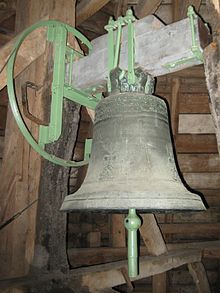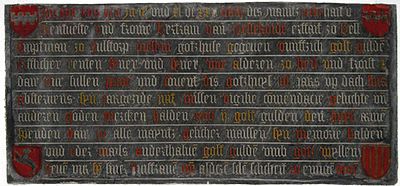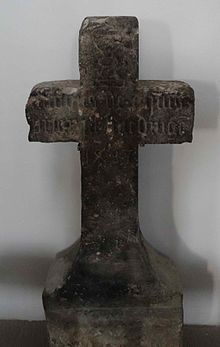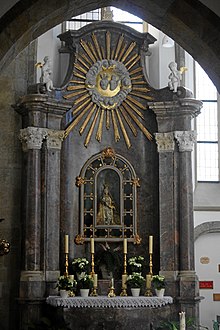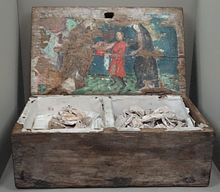Pilgrimage Church to the Sorrowful Mother of God (Bödingen)
The pilgrimage church to the painful mother of God is a Roman Catholic church building in Hennef- Bödingen, which has been a listed building since 1989 . It is one of 5 churches in the Hennef-Ost parish association and belongs to the Archdiocese of Cologne . In 1408 the building of the house of God was completed and was consecrated to the Blessed Virgin Mary and the Three Kings . The building has been the parish church of the parish of the painful mother since 1834 and is located right next to the monastery Bödingen , visible from afar, on the first ridge of the Nutscheid . The late Gothic basilica consists of two parts: the older part with an east-facing three-aisled nave and integrated west tower and the newer part - supplemented in two construction phases from 1439 with the transept and between 1490 and 1500 with a new choir in the east.
history
Legend
Around 1350 the simple worker Christian von Lauthausen had the Vesper picture of the "Mater Dolorosa" carved after an apparition of Mary in a Cologne workshop and first set it up in a wayside shrine next to his hermitage in the forest near Altenbödingen. Because of the large number of pilgrims, he wanted to build a chapel for this Pietà there, but it did not succeed because the walls kept falling down overnight. Then he had another shining apparition of the Mother of God, who commanded him to load his mule and follow it. The chapel was then built where the mule stopped in the wilderness.
Pilgrimage church and monastery
Pastor Meisenbach then began building a large pilgrimage church in 1397, which would do justice to the growing stream of pilgrims to this place. The church was built in honor of the miraculous image of the Mater Dolorosa . In 1408 the Church of the Sorrowful Mother and the Three Kings was consecrated. It is the oldest pilgrimage site of the Sorrowful Mother in Germany. In 1417 both builders of the church, Christian von Lauthausen and Peter Meisenbach died on September 17, 1417 and were buried there. After the introduction of the Compassion Festival , the Bödingen Monastery was founded by the Augustinian Canons in 1424 in order to be able to take care of the increased number of pilgrims. In order to be able to better separate the monastery church services from the pilgrimages, the church was expanded in 1439–1500 by a transept and a choir . The famous monastery reformer Johannes Busch (1399–1480) worked as a deacon in this monastery . It has been a Catholic parish church since the monastery was abolished. It has been a listed building since 1991.
description
architecture
The impression of the exterior is determined by the interaction of the four-storey west tower and the choir with a ten-cornered tent roof. The church is a three-aisled Gothic pillar basilica with a retracted tower, which is 24 m high in the masonry and 43.5 m high to the top of the helmet. The cross arms close on five sides. The choir was built between 1480 and 1500 instead of a smaller choir. The eaves cornice of this choir is approx. 0.7 m higher than that of the transept, while the base height is the same. The pointed choir roof was originally higher; its height was reduced by 6 m during the major renovation in 1884 for cost reasons. The roofs of the two side aisles also became flatter again: after they were attached to the main cornice of the central nave above the upper aisle windows until the renovation and thus completely covered them, they are again in the current and original design (see foundation picture from 1621) below. The reason for the change in the meantime was probably that a roof attached directly to the roof of the central nave was easier to seal. Further major renovations took place after the end of World War II and in the 1960s.
The basilica is made of quarry stone and faces east. It has four yokes with a low upper end . In the choir there is a glass window with a depiction of the crucifixion, the donor Archbishop Hermann von Hessen (1450–1508) is shown in the picture. In the central aisles and the two side aisles, the church offers space for 230 people. Since the renovation from 1960 to 1967, the stones of the load-bearing elements - especially the pillars, arches and ribs - have been visible inside. In addition, a statue of Mary by the sculptor Manfred Saul was mounted on the top of the choir roof and crushed the snake's head.
The total length is 35.3 m, the side aisles have a clear width of 3.70 m and the central nave is 5.50 m wide. In contrast to the usual Gothic architecture, the transept has a different width than the central nave, namely 4.45 m. The central nave is composed of 4 bays, of which only the western one has a square basic shape. The crossing, however, has a trapezoidal floor plan. This makes it possible to expand from the narrow central nave into the wider choir.
Except for the keystone in the choir, which is an open pine cone, all other keystones are decorated with leaf ornaments. In the south aisle, however, three keystones in the cross ribs differ in that they also show faces. They are part of the original equipment and are therefore over 600 years old. It can be assumed that these rough representations, which appear unfriendly, are to be seen as a threat from above, against which the Blessed Mother is supposed to protect those who pray. Why only these three keystones show such a face is unclear, especially since the Pietà only found its place in the south transept in the 17th century.
The vaulting of the two construction phases is quite different. In the older central nave, simply profiled ribs emerge from the pillars and walls. In the newer part (choir and transept) the ribs are taken up by services that are lowered deep and sit on beautifully crafted consoles. These are more elaborately designed in the south transept, which leads to the conclusion that more pilgrims used to stay here.
organ
history
An organ can already be seen on the foundation picture in the early 17th century. The instrument was hung high in the north transept as a so-called swallow's nest organ , which could be reached via its own stair tower. The Bödinger Memories Book documents a donation of 40 Reichstalers in 1674 for the renewal of the organ and the death of the organist Heinrich Luttegelhe in 1730.
In 1847 Eberhard Kraft from Poppelsdorf reported that an organ was revised and commissioned by the royal government. The result was that the instrument was in a very poor condition, especially due to woodworm infestation.
In 1912 the organ builder Johannes Klais ( Fa. Klais, Bonn ) delivered a new organ (Opus 479) from Bonn, which was placed in two parts on the western gallery that was still in existence at the time. The console was set up freely on the right gallery side and had two manuals, a pedal and originally 13 stops. An 8 ′ trumpet was added later.
In 1963 the gallery disappeared as part of the church renovation and the organ was placed again in the north transept. This organ was largely built from the old Klais organ by the organ builder Peter Busch from Troisdorf. It became a box-shaped case in which the two windchests were placed on top of each other and the trumpet 8 'became a trumpet 4'.
today
Today's organ at the western main entrance was built in 1997 by Orgelbau Schulte . The slider chest instrument has 24 registers on three manuals and a pedal. 8 of these registers could be taken over from the old Klais organ. The game actions are mechanical, the stop actions are electric.
|
|
|
|||||||||||||||||||||||||||||||||||||||||||||||||||||||||||||||||||||||||||||||||||||
- Manual I: Coupling I / P, II / P; various electrical sub- and super-octave couplings
Peal
Bells
77 steps lead to the belfry, which is approx. 20 m high, on the third floor of the west tower. There are three of the four bronze bells from 1397, 1398, 1470. The fourth bell from 1757 was procured by Prior Heinrich Klein and hangs over the choir.
|
Bell jar |
I. |
II |
III |
IV |
|---|---|---|---|---|
| Surname | Maria | John the Evangelist | - | Maria |
| Bell caster | Ailf from Wippervorde | Gerhard Duisterwalt, Cologne | Henricus Rosengarden, Cologne | Henricus Ross, Cologne |
| Casting year | 1470 | 1397 | 1398 | 1757 |
| metal | bronze | bronze | bronze | bronze |
| Diameter [mm] | 1430 | 1252 | 919 | 788 |
| Impact ring thickness [mm] | 119 (111/110) | 88 (81/82) | 67 (65/60) | 74 (63) |
| Weight approx. [Kg] | 1740 | 1200 | 450 | 350 |
| Proportion (Dm / Sr) | 1: 12.0 | 1: 14.3 | 1: 13.7 | 1: 10.6 |
| Strike / nominal | es' + 4 (D) | es'-3 (F) | a '+ 4 | it '' ± 0 |
| construction | Heavy rib | Light rib | Medium weight rib | Heavy rib |
| Oscillation period [s] | 2.4 | 2.25 | 2.0 | - |
- The oldest bell (called the midday bell) bears the inscription HOC VAS ORNATUM JOANNES EVANGELISTA NOMINATUM. ANNO DOMINI MCCCXCVII GERARDUS DUISTERWALT ME FECIT.
- The youngest bell does not hang in the tower, but above the choir and bears the three-line inscription: MARIA I HEAR, TO THE CHOIR I I PEOPLE, THE UNSTORMED I CHANGE. - CONFLATA CAMPANA HAEC CONSECRATA SVB PRAELATO HENRICO KLEIN. - HENRICUS ROSS COLON. ME FACIT 1757. The 27th prior, Heinrich Klein, had it poured. Except for the big festival bell, it rings 5 minutes before the start of the fair.
- The smallest of the three big bells from 1398 bears the inscription IN HONORE BEATAR VIRGINIS MARIAE HINRICUS ROSENGARDEN ME FECIT ANNO DOMINI MCCCXCVIII, V. SEPTEMBRIS. It bears a small relief depicting a knight on horseback killing a dragon with a lance.
- The largest bell from 1470 bears the inscription MARIA HEICCHEN (SO) ICH, IN EIR GOTZ LUEDDEN ICH, AL UNWEDDER I DISTRIBUTE. ANNO DOMINI MCCCCLXX. It is a masterpiece of Gothic bell casting and is far above the average of most medieval bells in terms of sound volume and singing temperature. It was confiscated in the last war, but returned unharmed to its place of use in 1947 under the bell ringer August Pütz. This bell is also used to strike the hour.
Pilgrim sign
The large Marien-Bell from 1470 has a special feature: it bears a proven pilgrimage mark , which is still in very good condition. Pilgrim signs are small metal castings that have been sold to pilgrims in places of pilgrimage since the mid-12th century. They depict the venerated saint, in this case Mary, the Mother of God. Each sign of pilgrimage is associated with a specific place of origin.
This symbol shows a rectangular shape with three crowning turrets. In the middle tower there is a round mirror frame below and a Gothic pointed arch arcade below. In it sits the crowned Mother of God with the body of Christ lying to the left with an adorant kneeling on each side. The picture is bordered on the left and right by two half-height finial-crowned pinnacles and measures 80 * 57 mm.
Foundation boards
In the right - i.e. southern - aisle there are two stone foundation deeds. The two rectangular panels are embedded in the wall and completely covered with an inscription in Gothic letters ( minuscule ), some of which are highlighted in red and yellow. In the four corners they have coats of arms, u. A. that of the Nesselrode (noble family) : a red coat of arms, with a double silver crenellated wreath pointing up and down.
Inscription plaque of Wilhelm von Nesselrode
The larger panel shows signs of an epitaph and is now to the right of the south portal. It measures 190 by 98 cm and is the older of the two panels, dated 1474. In 1962 it was moved from the north to the south nave as part of the repairs to the church. It was commissioned by Bertram von Nesselrode († 1510) for his father Wilhelm von Nesselrode Herr zum Stein († April 15, 1474). Wilhelm von Nesselrode is buried in the nave of the church, while his son Bertram is buried in the Ehrenstein monastery church .
At the top right is a coat of arms with a lion with its head in profile, which is the county coat of arms. Another coat of arms at the bottom right also shows a lion, but with the head en face, which is the coat of arms of the County of Sayn . The coat of arms on the lower left is partially destroyed: it is the three-diamond coat of arms of Stein
The text says:
| Original text | translation |
|---|---|
| 1 in dē jarē uns herē MCCCCLXXIIII of the XV day jndē aprille starff the strict here
2 wilhem van nesselroede knight here zom steyne dē got genade der selve eyne 3 eternal memories of syn synre alderē both synre huysvrauē jnde synrē nakomen 4 selē selcheit has been confirmed in desē gotz huse by dat gantze jare zo allen 5 maeyndē memorie jnde alle jars eyns up dē roof synre gracht jairgetzyde myt alle price [t] 6 meyssē vigylien jnde c [om] mendaciē zo doyn: dar zo he umb dat sulchs zo ewigē gedechtn [iys] 7 volbracht will be Gegevē dē hoff zo hasewynkel with IIII overlenschē guldē zwa aymē wy [n] 8 die man up zyt bȳnē dē mayndē as m de memorie jnde jairgetzide heldt verdoyn sall 9 as dē priestē II firdel wyns jnde dē conversē yederē I pot wyns jtem nor zwa aymen 10 wyns de man ewelich to the cōsecraciē des wirdigē hilligē Sacramētz up allen 11 parents urberē Sall jtem desen given parent hait her bertram van nesselroede 12 knights here zo erensteyn her wilhems son unde margrete sȳ huysvraue bestedige [t] 13 myt eȳre degeliger eternal myssē myt drȳ byrnēde kertzē bȳnē dē missē jnde dry [n] 14 lampē myt oley byrnēde roof jnd night ewelich jtē dē hoff zor heyden 15 jnd XV overlenschē guldē uis dē hoeve zo menden dem got genedich sy. |
1 In the years of our lord 1474 on the 15th day in April the stern lord died
2 Wilhe [l] m von Nesselrode, Ritter, Herr zum Stein, to whom God be gracious. The same one 3 eternal foundation for his, his parents, his two wives and his descendants 4 souls - namely everyone in this house of God throughout the year 5 month remembrance and every year on the day of his burial an annual remembrance with all priests 6 to keep with masses, wakes and intercessions: so that this is possible forever 7 he donated the farm in Hasewinkel to 4 Oberland guilders, two ohms of wine 8 to be distributed at the time of the masses and annual memorials of each month 9 The canons are to receive two quarters of wine and the lay brothers each one cup of wine and two more ohms 10 Wine that goes to the Consecration of St. To serve blood and body on all altars 11 should: and this present altar have Mr. Bertram von Nesselrode 12 Ritter, Herr zu Ehrenstein, Herr Wilhelm's son, and Margarete donated his wife 13 with a daily eternal mass with three burning candles during mass and three 14 oil lamps should burn day and night forever and the Hof zur Heyden 15 and 15 Oberland gulden from the court in Menden, to whom God is gracious. |
- ↑ 1. Swengen of Landsberg and 2. Eva von Oetgenbach-Ehrenstein
- ↑ Haswinkel Estate in Leichlingen
- ↑ one ohm corresponds to about 150 liters
- ↑ Bertram's Altar, consecrated to the Most Holy Trinity
- ↑ * 1435 † 1510, Wilhelm's son
- ^ Heiderhof, west of Stieldorf in the Rhein-Sieg district
Foundation deed of Bertrams von Nesselrode
The smaller panel is to the left of the south portal and is the younger panel at 136 by 78 cm, dated July 25, 1540. It was also commissioned by a Bertram von Nesselrode († February 16, 1541), but not the same is like the client of the larger record, but the great-grandson of the above Wilhelm von Nesselrode Lord of the Stone. It bears the coat of arms of the Nesselrode in the upper left and right corners. The right one of these coats of arms is not correct: it is the painting over of a destroyed coat of arms - it will have been the coat of arms of his wife Margarete von Etzbach. At the bottom left is a coat of arms with a jumping deer, the coat of arms of the (step) mother Bertram, Eva von Oetgenbach and on the bottom right the coat of arms of Merode, the family of Margarete's mother. This board is a deed of foundation and not an epitaph because the date of death is missing. The founder died a year later and is buried in the nave of the church. The grave slab is the eighteenth of the slabs that are now in the outer church wall.
The text says:
| Original text | translation |
|---|---|
| 1 in the jair ons here MV c and XL dē XXV. roof of the maintz julij hait d [ē]
2 Erentveste and frome bertram van Nesselroide erffait zo bell 3 Amptman zo Lulstorp this gotzhuse Gegeven vunffzich golt guldē 4 available pensions syner and syner vur alderen zo heil und troist 5 dair vur sullen prior and cōvent dis gotzhuys al jairs up dach sins 6 abstervens syn jairgezide with missen vigilie cōmendacie geluchte u 7 other goden wercken halden and II golt gulden den huys poor 8 donations dair zo alle mayntz gelicher maissen syn memorie halden 9 and eder mails anderthalvē golt guldē umb gotz wyllen 10 gevē vur sȳ siner huisfrauē u alderē selē selicheit zo ewigē dagē |
1 In the year of our Lord 1540, the 25th day of July has
2 honorable and pious Bertram von Nesselrode, Bailiff of Bell, 3 bailiff in Lülsdorf, this church 50 gold guilders 4 hereditary pensions given to his and his ancestors / parents salvation and comfort. 5 For this purpose, the prior and convent (members) of this church are supposed to be on the day of his death every year 6 its annual memory with masses, wakes, intercessions, lights and 7 other good works - and 2 gold guilders they shall do for the poor Donate 8 - also keep / celebrate your memory equally every month. 9 And each time they are to receive one and a half gold florins for God's blessing 10 to give bliss for his, his wives and his parents' souls - forever. |
In 1803, these two documents resulted in Bödingen becoming a parish in 1834 and the church and monastery buildings preserved. In the course of secularization , church property fell to the state from 1803 and was sold or, in the case of buildings, also demolished. For Bödingen, however, the Prussian state recognized the two stone documents as a valid contract in which spiritual services "zo eternal days" - that is, forever - are to be provided with income from farms and other money.
- ↑ * 1500 † 1541, great-grandson of the above-mentioned Wilhelm von Nesselrode from the Ehreshoven line
window
The windows were mainly made by the glass painter Paul Weigmann between 1967 and 1972 in the glass painting company Oidtmann (Linnich). They represent:
| place | description |
|---|---|
| West window (above the organ) | All come to worship the Lamb (in the top of the round window) in the midst of the heavenly Jerusalem. Mary, who crushes the serpent's head, gathers around the resurrected, who pay homage to the Lamb. |
| Window over the south portal | The Lord's Supper |
| Window over the north portal | St. Francis de Sales with his book Philothea |
| north aisle above the confessional in the tracery | The dove of the Holy Spirit over the waters |
| south transept | Christian von Lauthausen, kneeling in front of the miraculous image in a wayside shrine, at the place of the apparition of Mary in the forest of old Bödingen (today Altenbödingen). |
| south transept | Spiritual rulers (from left to right): Pope Martin V , Dietrich von Moers (Archbishop of Cologne), Wilhelm Spies (Abbot of Siegburg), Johannes Meiner (Provost of Bonn). |
| south transept | The 15th prior of the St. Augustine monastery in Bödingen, Balthasar von Sollingen. He had the foundation picture reproduced in 1621 from an older picture that existed from 1500 until then. In the background three Augustinian Canons celebrating the dedication mass at the rood screen altar. |
| south transept | Excerpt from the foundation picture, where the pilgrims and pilgrims are shown. |
| Choir (middle) | The middle choir window was made by a master of the Cologne School of Painting around 1508 and shows in the upper half Mary (left) and Johannes (right) under the cross, at Jesus' feet St. Mary Magdalene. Below in the lower half, kneeling on the left: Hermann von Hessen (1450–1508) , Archbishop of Cologne (founder of the window), behind him a saint; on the right St. Elisabeth of Thuringia, the patroness of Hesse. The identity of the saint behind Hermann von Hessen is disputed: either it is St. Augustine (namesake of the Augustinian Canons) or St. Petrus (Hermann's patron). |
All windows are made of antique glass, lead and black solder.
Crypts
There are three tombs under the church: two under the central nave and one under the south transept, which means that it comes from the second phase of construction around 1439. The two tombs under the central nave each had their own entrance. The access to the third crypt under the transept leads through a subsequently created corridor under the south aisle. A passage to the central crypt was also pierced from this, through which no coffins could be transported.
Today the eastern crypt under the central nave and the one under the transept can still be reached through the shared entrance. The separate access to the eastern crypt and the access to the western crypt are permanently locked, the latter due to the new organ that stands on it. All of the tombs were looted at the beginning of the 19th century to turn metals and valuables into money.
As was common in the Middle Ages, special personalities were buried in the tombs. The eastern crypt under the central nave was the burial place of those of Nesselrode, the western one of those of Gevertzhagen zu Attenbach. In the crypt under the south transept lay special patrons of the church and the monastery, as well as residents of Allner Castle.
Further equipment
Jacobus Cross
On September 27, 2015, a pilgrim cross, the so-called Jacobus cross, was consecrated in the baptistery (north transept) of the church. In 1485, the 8th prior of the Augustinian Canons' Monastery in Bödingen, Father Jacobus von der Heggen, who came from Aachen and was nicknamed "de Aquis" (from Aachen), died. He was a friend of pilgrims from Holland, who once a year took the long walk to Bödingen to see the Sorrowful Mother. In 1487, two years after the prior's death, these pilgrims donated a stone cross when they visited again and set it up on the pilgrimage route. The cross may initially have been near the church in Bödingen, but four other locations are mentioned in the most varied of scripts. Whether the last location in 1981 in the Siegenhardt von Seligenthal was the original location can therefore not be proven. The stone cross is made of Drachenfels trachyte (which was also used in Cologne Cathedral) and has the shape of a Latin bar cross. It bears the image of a goblet at the top and below it the inscription in Gothic minuscule:
jacobus de aquis
prior in boedingē
1487
The word Bödingen has the ligature "ē" for "en" at the end, probably for reasons of space .
The "4" is written as a half 8, open at the bottom, a spelling common in the Middle Ages, from which the 4 that is common today arose later.
Image and altar of grace
The grace or Vesper image - the Pietà - is a 66 cm high wooden figure of the seated Madonna and certainly dates from the middle of the 14th century. The grace image was initially in a wayside shrine in the forest between Lauthausen and Altenbödingen and was placed on the high altar in 1408 of the completed church. In 1439 the miraculous image was moved from the high altar to an altar (rood screen altar) that was specially erected at the entrance to the choir, so that two altars were now one behind the other. The high altar was reserved for the canons, while the rood screen altar was intended for the "people", i.e. the community. Under the 17th prior of the monastery, Gottfried Worm, the rood screen was torn down in 1630 and the miraculous image was placed on a wooden side altar in the south transept. This was sold to Stieldorf in 1750 under the 27th prior, Heinrich Klein, and replaced by today's baroque marble altar. The figure is located in a glazed niche made of green stucco marble that looks like a tabernacle. The altar itself consists of Lahn and stucco marble, pillars and pillars bases and capitals are made of limestone. Two steps made of red marble were prematurely removed as part of the church restoration in 1961 and replaced by a step - made of black marble for cost reasons - during the subsequent complete restoration of the altar. The miraculous image is clothed in a robe made of precious silk, so that only the face and hands of the Mother of Sorrows can be seen. A conspicuously small Christ lies on her lap and is not supported by Mary's left hand, but only hangs on a ribbon. The body of the little Christ had to be renewed in 1922 because the original had been stolen.
painting
In addition to several paintings inside the church, the most important oil painting hangs in the rectory next to the Catholic library and can be viewed there during opening hours. It is the so-called "foundation picture", i.e. the foundation picture, painted in the early modern period in 1621 based on - but not over - an older model. It measures 1.5 by 2.7 m, making it the largest painting in the church. In its representation it is divided into three parts like a winged altar, in the middle picture the inauguration of the new choir is shown. The rood screen wall (the rood screen ) with the lay or rood screen altar and the swallow's nest organ are clearly recognizable . Secular and spiritual dignitaries are shown standing on the left and right. The founder kneels down with his coat of arms and the inscription:
AD SUI SUAEQUE FAMILIAE MEMORIAM DP BALTHASAR SOLLINGEN DE COLONIA, XV. PRIOR HUIUS DOMUS, PRESENTEM FUNDATIONIS TABULAM AD EXEMPLAR ANTIQUM FF ANNO DOMINI MDCXXI, AUGUST VII.
Translated: In his and his family's memory, Father Balthasar Sollingen from Cologne, the 15th prior of this house, had the current foundation picture made from an old original on August 7, 1621.
In the left part of the picture the donor of the miraculous image, Christian von Lauthausen, can be seen praying in the forest in front of the Pietà. In addition, the exterior view of the church, the Sieg, Kloster Merten , House Attenbach and the Blankenberg Castle are shown. This is one of the oldest pictures by Blankenberg. The Siebengebirge with the Löwenburg can be seen in the background . In the right part of the picture there are several pilgrims on their way to Bödingen, where they cross the Bröl on a footbridge. In the background you can see an old view of Siegburg with the Michaelsberg Abbey , on the horizon the Rhine with the cities of Cologne and Bonn, with the mouth of the Sieg in between. Cologne is characterized by the unfinished south tower of Cologne Cathedral with the cathedral crane on it . Below Siegburg lies Gut Zissendorf, at the same height on the right Happerschoss with the original church, above Seligenthal .
In the central nave there are men in two rows - in the left row from back to front the clergy: Pope Martin V , Archbishop of Cologne Dietrich von Moers , Wilhelm Spies von Büllesheim as Abbot of Siegburg and Johannes Meiner as provost of the Casius Stift in Bonn. In the right row from back to front the seculars: Emperor Sigismund and the dukes Wilhelm, Adolf and Robert von Berg. Adolf holds the Bödinger deed in his hand.
Grave monument of Elisabeth von Nesselrode-Ehreshoven
The falsely so-called "Steinsche Altar" is a grave monument of Elisabeth von Nesselrode-Ehreshoven, née Schwarzenberg, on the wall in the south aisle next to the staircase to the west tower, which has been there since 1977. This marble epitaph was donated by Wilhelm von Nesselrode , Chancellor of the Duchy of Jülich-Berg and bailiff of Blankenberg in 1600 in memory of his wife von Nesselrode-Ehreshoven, Baroness Maria Elisabeth von Schwarzenberg, who died on June 8, 1599. The figure of the deceased is made of white marble, kneeling in front of a crucifix (20th century). The middle black slate is framed by 16 coats of arms on red marble. Eight coats of arms are still in their original state and eight were reproduced and replaced by the sculptor Tophinke from Koblenz in the middle of the 20th century, including the coat of arms of those of Nesselrode (the fourth from the bottom on the left). In the top, a relief shows the raising of Lazarus , below an inscription describes the virtues of the deceased.
The text says:
| Original text | translation |
|---|---|
| Illustri Genere ac virtute Praeclarissima Domina Elisabetha Baronissa de Schwartzenburg, quae cum generis Claritate, Morium elegantiam honorisque Dignitatem Laudabiliter adjunxisset et annos 42os in vera fide et Charitate erga deum et Proximum complevisset, tandem in Ipso aetatis Flore et Gloriae supercursors cum moerore transit June 8th Anno 1599, cui Wilhelmus a Nesselrat in Ehresboven, illustrissimi Principis etc. in Utroque Ducatu Juliacensi et Montensi Consiliarius, Cancellarius et Satrapa in Blanckenberg, individuae Societatis Memor. Uxori suae Dilectissimae, cum qua in Amore conjugali vixit Annos 20ti, Lugens Moerensque posuit Anno 1600. Vivite ut Morituri et Orate pro ea. | The highly respected Mistress Elisabeth, Baroness von Schwartzenburg, noble of origin and character, combined fine morals and a dignified appearance in a commendable way with the nobility of her gender. She died at the age of 42 in the prime of a life of true loyalty and love for God and her fellow human beings, from which she was carried away by dropsy on June 8, 1599, respected by everyone, and mourned by many people. For her, his dearly beloved wife, with whom he had been connected in conjugal love for 20 years, this monument was erected by Wilhelm von Nesselrode zu Ehreshoven, the dukes of Jülich and Berg counselor, chancellor and governor in Blankenberg, in memory of this inseparable relationship, in mourning and full of pain, in the year 1600. Live like the deceased and pray for her! |
Originally the tomb was in the north aisle. Elisabeth von Schwarzenberg was buried in the family crypt of the Nesselrode under the nave.
- ↑ Great-great-great-grandchildren from the Ehreshoven line of the above Wilhelm von Nesselrode Herr zum Stein, * 1549, † 1585
Relics
Since 2011 there has been a reliquary box in the church that can be viewed during the church tours. It contains the relics of St. Gereon and his comrades, which Duke Adolf VII von Jülich and Berg (1408–1437) brought from his castle in Düsseldorf to Bödingen in 1420.
Lamentation group
The " Beweinungsgruppe " is a colored wooden sculpture, made around 1450, which was placed in a Halberg chapel below Bödingen until World War II and was then bequeathed to the Redemptorist monastery in Hennef-Geistingen. After its dissolution in 2006, the sculpture was examined by students of the Cologne University of Applied Sciences and extensively restored. Since 2011 it has been clearly visible on the pillar on the right in front of the organ on a stone stele. The sculpture depicts Mary praying in the middle, on the right Mary Magdalene is kneeling holding Jesus' hands and on the left is John holding the head and upper body of Jesus. So Maria has her hands free and can let go or pull her son. The dead Christ lies on the lap of his mother, like the crossbeam on the cross, who protrudes from the group like a throne. This is the oldest known sculpture of such a depiction of lamentation!
Annunciation fresco
The so-called "Annunciation fresco" is one of the oldest art objects in the church. It is located on the east side of the north aisle and is the last remnant of the medieval painting of the church. It dates from the time the transept was built around 1450 and was probably created by a Cologne artist. The fresco depicts the Lord's Annunciation to Mary and has seen several changes over time. In 1884, as part of the neo-Gothic church decoration, it was completely painted over with oil paint and greatly changed in the process. In 1940 the first restoration was carried out by Prof. Hübner from Cologne. In 1988 and 2008 the fresco was restored again; but if possible left in the style of 1884. At 158 × 148 cm, it is the third largest painting after the foundation picture and an oil painting entitled "Jesus meets his mother" in the rectory.
The viewer of the picture looks into a room. This impression of spatial depth is graphically created by the front and rear elements and is additionally reinforced by the inclusion of the sloping window sill below and above the fresco. This created a spatial illusion through the unique interplay of architecture and painting.
Just like the foundation picture, this mural is also divided into three sections by three arches on two pillars:
- on the left the angel Gabriel brings his message "Ave Maria Gratia Plena" (Hail Mary, full of grace)
- in the middle there is a lily as a symbol for Mary's virgin purity and God the Father sends the Holy Spirit from a cloud in the form of a dove
- on the right stands Maria in a blue robe in a humble posture, which is at the same time questioning / surprised and accepting
Together, these three parts form the space in which the angel and Mary are and which is typical for such an annunciation scene.
today
The pilgrimage church of the Sorrowful Mother of God is open daily from 9 a.m. to 6 p.m. Services take place every Sunday at 9:45 a.m. and on Wednesdays and Fridays at 6:00 p.m. Church tours take place regularly, but can also be booked on special request. Information on this can be obtained from the parish office.
literature
- Anton Henze: Rhineland and Westphalia: architectural monuments. 5th edition. Reclam, Stuttgart 1975, ISBN 3-15-008401-6 . ( Reclam's Art Guide Germany. Volume 3)
- Rheinische Kunststätten, issue 119. 3rd, revised edition. 1990, ISBN 3-88094-659-0
- Edmund Renard: The art monuments of the Rhine province. Volume 5: Siegkreis . Düsseldorf 1907. Printed and published by L. Schwann
- Leonie Countess von Nesselrode: The memory of Wilhelm von Nesselrode in Bödingen and Ehrenstein Rheinlandia Verlag Klaus Walterscheid, Siegburg 2013, ISBN 978-3-981604-11-5
- Gabriel Busch: Bödingen is worth a pilgrimage to Reckinger Siegburg 1981
- P. Mauritius Mittler OSB: Das Bödinger Memorienbuch, Respublica-Verlag Siegburg, 1971
Web links
- Description on the website of Hennef-Bödingen
- Description on the website of the home association Bödingen
- Notes on the website of the Archdiocese of Cologne
- List of bells from www.glockenbuch.de
- Pilgrimage church "To the painful mother of God" - The church and its bells inside the WDR bell gate ; accessed on January 20, 2018
- Pilgrim Sign Database
- Description of the windows
- Pilgerkreuz / Bödingen / OT von Hennef (Sieg) on the pages of suehnekreuz.de - specialist portal for land monument research
Individual evidence
- ↑ Monuments in Hennef List of Monuments of the City of Hennef , Part A, Architectural Monuments; accessed on January 20, 2018.
- ↑ MAGAZINE FOR CHRISTIAN ART 1888, Issue 9, Col. 297f
- ^ Rhineland and Westphalia: Architectural monuments. 5th edition. Reclam, Stuttgart 1975, ISBN 3-15-008401-6 , pp. 82-83.
- ↑ http://www.orgelbau-klais.com/_klais/bilder/pdf/Opusliste.pdf
- ↑ More information about the organ
- ↑ RHEINISCHE KUNSTSTÄTTEN, No. 119. 3rd, revised edition. 1990, ISBN 3-88094-659-0 , p. 25
- ^ Leonie Gräfin von Nesselrode: The memory of Wilhelm von Nesselrode in Bödingen and Ehrenstein, p. 56, Rheinlandia Verlag Klaus Walterscheid, Siegburg 2013, ISBN 978-3-981604-11-5
- ↑ http://wiki-de.genealogy.net/Herrschaft_Ehrenstein
- ↑ RHEINISCHE KUNSTSTÄTTEN, No. 119. 3rd, revised edition. 1990, ISBN 3-88094-659-0 , pp. 26-27
Coordinates: 50 ° 46 ′ 55.8 " N , 7 ° 20 ′ 26.4" E
